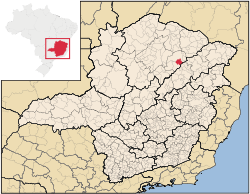
Cristália
Encyclopedia

Minas Gerais
Minas Gerais is one of the 26 states of Brazil, of which it is the second most populous, the third richest, and the fourth largest in area. Minas Gerais is the Brazilian state with the largest number of Presidents of Brazil, the current one, Dilma Rousseff, being one of them. The capital is the...
. In 2007 the population was 5,731 in a total area of 841 km². The elevation is 728 meters. It became a municipality in 1962.
Location and Distances
Cristália is located in the Serra do Espinhaço mountains east of Montes ClarosMontes Claros
Montes Claros is a city located in northern Minas Gerais state, in Brazil. The estimated population in 2010 was 412,284 inhabitants and the total area of the municipality was 3,470 km²...
. It is 18 km south of Grão Mogol
Grão Mogol
Grão Mogol is a Brazilian municipality located in the north of the state of Minas Gerais. In 2007 the population was 14,954 in a total area of 3,890 km². The elevation is 829 meters. It became a municipality in 1840.-Location and Distances:...
and is connected by dirt road. The Rio Congonhas, a tributary of the Rio Jequitinhonha, flows to the north.
Cristálila is part of the statistical microregion of Grão Mogol. The distance to Belo Horizonte
Belo Horizonte
Belo Horizonte is the capital of and largest city in the state of Minas Gerais, located in the southeastern region of Brazil. It is the third largest metropolitan area in the country...
is 354 km.
Economic activities
The most important economic activities are cattle raising (5,000 head in 2006) and agriculture. The GDP in 2005 was R$ 16,261,000. The most important agricultural crops are bananas, coffee, tropical and citrus fruits, peanuts, sugarcane, and corn. There was also production of charcoal from eucalyptus plantations and lumber. In the rural area there were 503 producers. The total area of agricultural land was 12,987 hectares in 2006. As of 2006 there was only one tractor. In the urban area there were no banking agencies in 2006.Health and education
This municipality is isolated from major population centers and suffers from drought and poor soils.- Municipal Human Development IndexHuman Development IndexThe Human Development Index is a composite statistic used to rank countries by level of "human development" and separate "very high human development", "high human development", "medium human development", and "low human development" countries...
: .647 (2000) - State ranking: 751 out of 853 municipalities as of 2000
- National ranking: 3,806 out of 5,138 municipalities as of 2000
- Degree of urbanization: 46.48% (2000)
- Infant mortality rate: 16.00 (2000) The rate for Minas Gerais was 17.40; the rate for Brazil was 18.91.
- Illiteracy rate: 29.89% (15 years old or older)(Data from 2000) The rate for Minas Gerais was 11.96; the rate for Brazil was 13.63
- Urban area covered by sewage system: 0.50%--the rate for Minas Gerais was 81.39%
- Health clinics, health centers, and hospitals: 2, 2. There were no hospitals.

